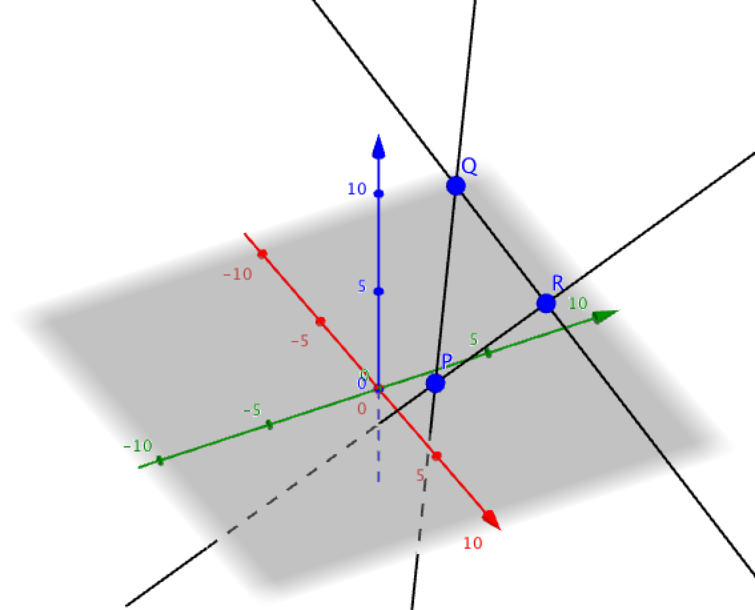Here are the vector equations of three lines.
\(\mathbf{a}=\begin{pmatrix}4\\0\\-2\end{pmatrix}+\alpha\begin{pmatrix}-1\\1\\4\end{pmatrix}\)
\(\mathbf{b}=\begin{pmatrix}1\\3\\10\end{pmatrix}+\beta\begin{pmatrix}-2\\-1\\2\end{pmatrix}\)
\(\mathbf{c}=\begin{pmatrix}2\\-1\\0\end{pmatrix}+\gamma\begin{pmatrix}1\\2\\2\end{pmatrix}\)
Before doing any calculations,
- try to visualise the lines in 3D space. What can you say about them?
- do you think any of them might be parallel or perpendicular?
- might they intersect?
If any two of the lines were parallel, their direction vectors would be the same or related by a scalar multiple. The distribution of positive and negative components is enough to see that this isn’t going to be the case.
Spotting perpendiculars and intersections is tricky without calculation but you may have been able to predict by visualising the lines.
If you have learnt about the dot product then you can check for perpendicular vectors with a straightforward calculation, but intersections require the solution of simultaneous equations as we shall see below.
Now check your predictions and work out what geometrical shape or pattern the lines make.
In 2D, a pair of lines always have an intersection unless they are parallel. Is this true in 3D?
Let’s start by looking for an intersection between lines (A) and (B). If they intersect, there will be some values of \(\alpha\) and \(\beta\) for which \(\mathbf{a}=\mathbf{b}\). In other words, \[\begin{pmatrix}4\\0\\-2\end{pmatrix}+\alpha\begin{pmatrix}-1\\1\\4\end{pmatrix}=\begin{pmatrix}1\\3\\10\end{pmatrix}+\beta\begin{pmatrix}-2\\-1\\2\end{pmatrix}\]
Equating each of the \(x\), \(y\) and \(z\) components we have, \[\begin{align} 4-\alpha &=1-2\beta \label{eq:ab-x} \\ 0+\alpha &= 3-\beta \label{eq:ab-y} \\ -2+4\alpha &= 10+2\beta \label{eq:ab-z} \end{align}\]We have three equations and two unknowns. If there is a unique solution, then the two lines intersect. If there is no solution they do not.
Why do we have to check all three equations? What would it mean if we had a solution to \(\eqref{eq:ab-x}\) and \(\eqref{eq:ab-y}\) that did not satisfy \(\eqref{eq:ab-z}\)?
Combining \(\eqref{eq:ab-x}\) and \(\eqref{eq:ab-y}\) we get \(\beta=0\) and \(\alpha=3\). By substituting, we find that these values do satisfy \(\eqref{eq:ab-z}\) and so the two lines do intersect. The point of intersection is found by substituting \(\alpha\) into (A) or \(\beta\) into (B). It is \((1,3,10)\).
Repeating this process for the other pairs of lines we find that each pair intersects. We decided to label the points of intersection as follows.
- and (C) intersect at \(P=(3,1,2)\)
- and (B) intersect at \(Q=(1,3,10)\)
- and (C) intersect at \(R=(5,5,6)\)
These coordinates have nothing obvious in common, but thinking about the geometry we can see that if three straight lines all intersect at distinct points they must all lie in a plane. The lines form the edges of a triangle in that plane.


